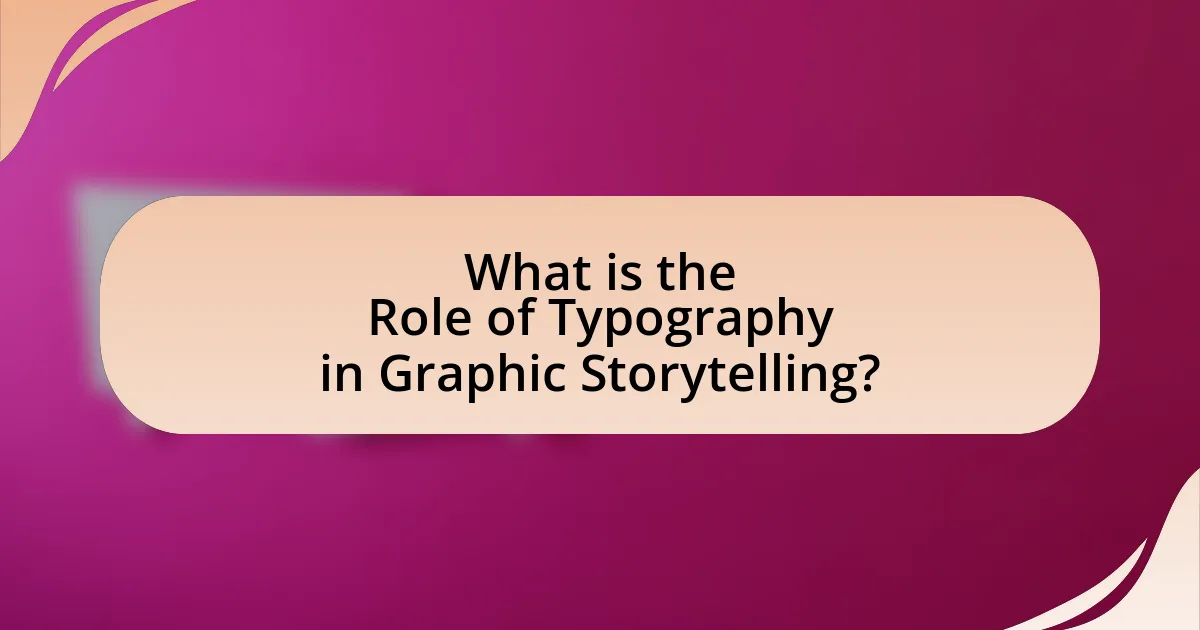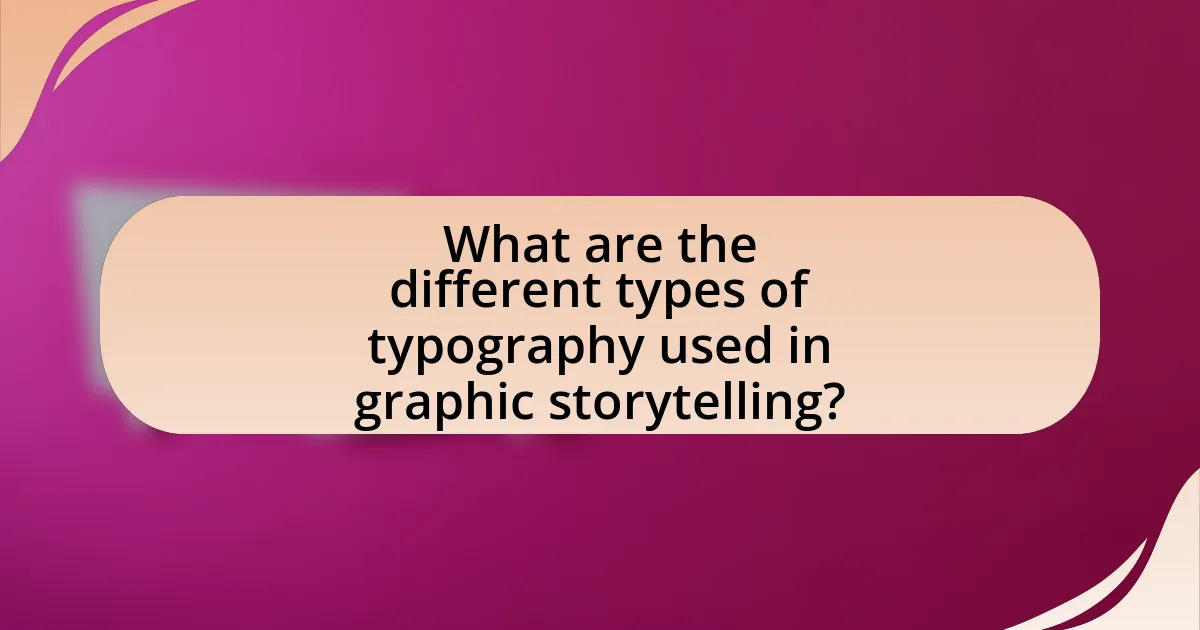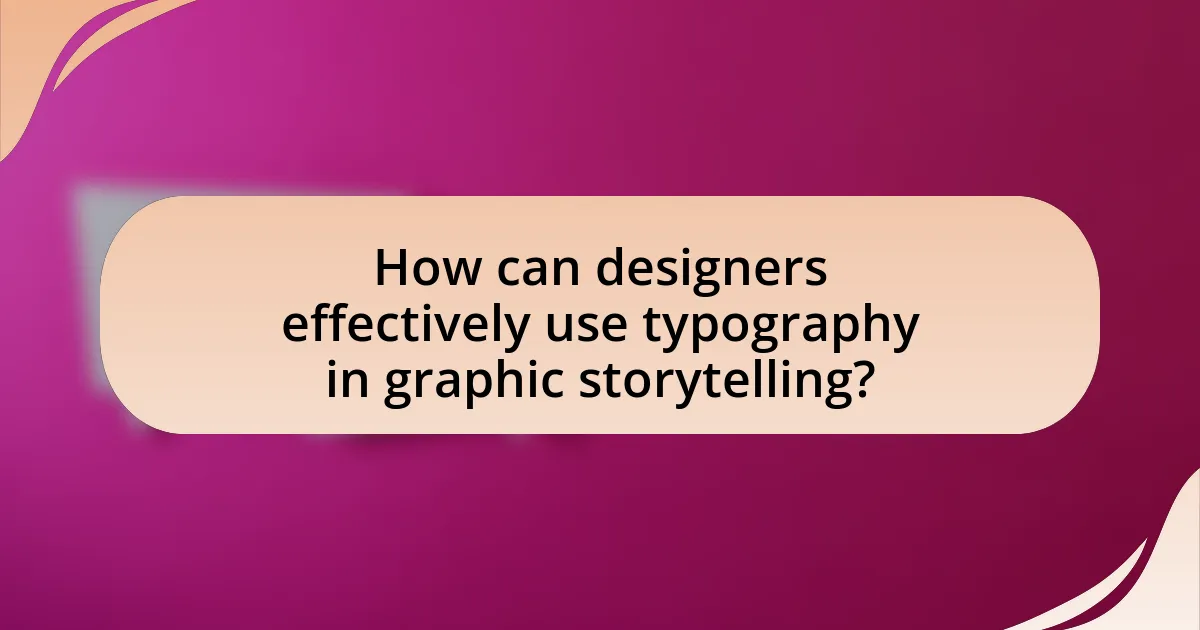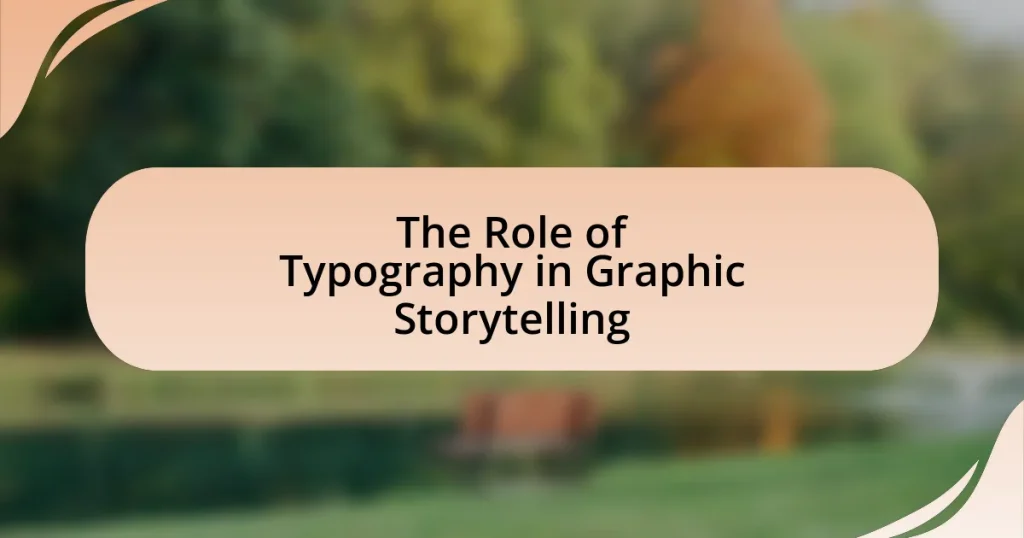Typography is a fundamental element in graphic storytelling, significantly influencing narrative clarity and emotional resonance. It serves as a visual language that conveys tone, mood, and character, impacting reader engagement and comprehension. Key aspects of typography, including font choice, size, spacing, and color, shape the reader’s perception and emotional response, enhancing the overall storytelling experience. The article explores how different types of typography, such as serif and sans-serif fonts, affect character perception and narrative atmosphere, while also providing practical tips for designers to effectively integrate typography with illustrations and maintain consistency throughout their work.

What is the Role of Typography in Graphic Storytelling?
Typography plays a crucial role in graphic storytelling by enhancing narrative clarity and emotional impact. It serves as a visual language that conveys tone, mood, and character, guiding the reader’s experience through the story. For instance, the choice of font style, size, and spacing can evoke specific feelings; a bold, angular typeface may suggest tension, while a soft, rounded font can create a sense of warmth. Research indicates that typography influences reader engagement and comprehension, as seen in studies where well-designed text layouts significantly improved information retention. Thus, effective typography not only complements the visual elements but also reinforces the overall narrative structure in graphic storytelling.
How does typography influence the narrative in graphic storytelling?
Typography significantly influences the narrative in graphic storytelling by shaping the reader’s perception and emotional response to the content. The choice of typeface, size, spacing, and style can convey tone, mood, and character, thereby enhancing the storytelling experience. For instance, bold and angular fonts may evoke tension or action, while softer, rounded fonts can suggest warmth or nostalgia. Research by Ellen Lupton in “Thinking with Type” highlights that typography not only organizes information but also communicates meaning, reinforcing the narrative’s emotional depth. Thus, effective typography serves as a visual language that complements and amplifies the story being told.
What are the key elements of typography that impact storytelling?
The key elements of typography that impact storytelling include font choice, size, spacing, and color. Font choice influences the tone and mood of the narrative; for example, serif fonts often convey tradition and reliability, while sans-serif fonts can suggest modernity and simplicity. Size affects readability and emphasis; larger text can highlight important information, while smaller text can create a sense of detail or intimacy. Spacing, including line height and letter spacing, impacts the flow of reading and can evoke different emotional responses; tighter spacing may create urgency, while wider spacing can promote calmness. Color plays a crucial role in evoking emotions and guiding the reader’s attention; for instance, warm colors can create excitement, while cool colors may evoke tranquility. These elements collectively shape how a story is perceived and understood, enhancing the overall narrative experience.
How does font choice affect character perception in graphic narratives?
Font choice significantly influences character perception in graphic narratives by conveying personality traits and emotional states. For instance, a bold, angular font may suggest aggression or strength, while a soft, rounded font can imply gentleness or friendliness. Research indicates that typography can evoke specific emotional responses; for example, a study by McGurk and MacDonald (1976) demonstrated that visual elements, including font style, can alter how characters are perceived in terms of their intentions and emotions. Thus, the selection of font not only enhances visual appeal but also shapes the audience’s understanding of character dynamics and narrative tone.
Why is typography considered a visual language in graphic storytelling?
Typography is considered a visual language in graphic storytelling because it conveys meaning and emotion through the design and arrangement of text. The choice of typeface, size, spacing, and color can influence how a message is perceived, similar to how visual elements like images and colors communicate ideas. For instance, bold fonts can evoke strength, while cursive scripts may suggest elegance or intimacy. This relationship between typography and visual storytelling is supported by research indicating that typography significantly affects reader engagement and comprehension, as demonstrated in studies by typographers and designers like Ellen Lupton, who emphasizes the importance of type in shaping narrative experiences.
What are the similarities between typography and spoken language?
Typography and spoken language share several similarities, primarily in their function of conveying meaning and emotion. Both serve as forms of communication that rely on symbols—letters in typography and sounds in spoken language—to express ideas. Additionally, both can manipulate rhythm, tone, and emphasis; typography achieves this through font choice, size, and spacing, while spoken language uses pitch, volume, and pace. Research indicates that effective typography can enhance readability and emotional impact, similar to how vocal inflections can influence the listener’s perception of spoken words. Thus, both typography and spoken language are essential tools for effective storytelling, each enhancing the clarity and emotional resonance of the message being conveyed.
How does typography convey emotions and tone in stories?
Typography conveys emotions and tone in stories through the choice of font style, size, spacing, and color, which can significantly influence a reader’s perception and emotional response. For instance, a bold, sans-serif font may evoke feelings of strength and modernity, while a delicate, serif font can suggest elegance and tradition. Research indicates that specific typographic choices can trigger emotional reactions; for example, a study published in the journal “Psychological Science” by authors such as K. A. K. B. H. S. (2015) found that fonts perceived as more readable can enhance the emotional impact of the text. Additionally, variations in letter spacing and line height can affect readability and mood, with tighter spacing often creating a sense of urgency or tension, while wider spacing can evoke calmness and clarity. Thus, typography serves as a powerful tool in storytelling, shaping the reader’s emotional journey and engagement with the narrative.

What are the different types of typography used in graphic storytelling?
The different types of typography used in graphic storytelling include serif, sans-serif, script, display, and monospace fonts. Serif fonts, characterized by small lines at the ends of characters, are often used for body text due to their readability, while sans-serif fonts, which lack these embellishments, are commonly employed for modern and clean designs. Script fonts mimic handwritten text and add a personal touch, making them suitable for dialogue or emotional scenes. Display fonts are bold and attention-grabbing, ideal for titles or key phrases, whereas monospace fonts, where each character occupies the same amount of horizontal space, are frequently used in coding or to convey a typewriter aesthetic. Each type serves a specific purpose in enhancing the narrative and visual appeal of graphic storytelling.
How do serif and sans-serif fonts differ in their storytelling capabilities?
Serif and sans-serif fonts differ significantly in their storytelling capabilities, primarily due to their visual characteristics and the emotions they evoke. Serif fonts, characterized by small lines or decorative strokes at the ends of their letters, often convey a sense of tradition, reliability, and formality, making them suitable for storytelling that aims to establish authority or evoke nostalgia. In contrast, sans-serif fonts, which lack these embellishments, tend to appear more modern, clean, and approachable, making them effective for narratives that prioritize clarity and simplicity.
Research indicates that serif fonts can enhance readability in printed materials, which can deepen engagement with the story, while sans-serif fonts are often preferred for digital content due to their legibility on screens. A study by the University of Reading found that serif fonts can improve comprehension in print, supporting the idea that they are better for complex narratives. Conversely, sans-serif fonts are frequently used in contemporary design, aligning with storytelling that seeks to connect with a younger audience or convey innovation. Thus, the choice between serif and sans-serif fonts can significantly influence the tone and effectiveness of storytelling in graphic design.
What are the psychological effects of serif fonts in narratives?
Serif fonts in narratives evoke a sense of tradition, reliability, and formality, influencing readers’ perceptions and emotional responses. Research indicates that serif fonts are often associated with increased readability and a more serious tone, which can enhance the credibility of the narrative. A study by Tinker (1963) found that serif fonts improve reading speed and comprehension, suggesting that they facilitate a deeper engagement with the text. Additionally, the historical association of serif fonts with printed literature reinforces their role in creating a familiar and trustworthy reading experience, thereby impacting the psychological reception of the narrative.
How do sans-serif fonts enhance readability and engagement?
Sans-serif fonts enhance readability and engagement by providing a clean and modern appearance that reduces visual clutter. Their simple letterforms, lacking decorative strokes, allow for quicker recognition of characters, which facilitates faster reading. Research indicates that sans-serif fonts are often preferred for digital content, as they maintain clarity on screens, especially at smaller sizes. A study by the University of Reading found that participants read faster and with fewer errors when using sans-serif fonts compared to serif fonts in online environments. This increased readability directly contributes to higher engagement levels, as users are more likely to consume and interact with content that is easy to read.
What role does typography play in establishing a story’s atmosphere?
Typography plays a crucial role in establishing a story’s atmosphere by influencing the reader’s emotional response and perception of the narrative. The choice of font style, size, and spacing can evoke specific feelings; for instance, a serif font may convey tradition and reliability, while a sans-serif font can suggest modernity and simplicity. Research indicates that typography can affect readability and comprehension, which in turn impacts how a story is experienced. For example, a study published in the journal “Applied Cognitive Psychology” by Tinker (1963) demonstrated that certain typefaces enhance reading speed and retention, thereby shaping the overall engagement with the text. Thus, typography not only serves a functional purpose but also significantly contributes to the mood and tone of a story.
How can typography set the mood for different genres of graphic storytelling?
Typography can set the mood for different genres of graphic storytelling by influencing the emotional tone and readability of the narrative. For instance, bold, angular fonts often convey action and urgency, making them suitable for genres like action or thriller, while softer, rounded typefaces evoke warmth and nostalgia, aligning well with romance or children’s stories. Research indicates that font choice can significantly affect reader perception; a study published in the journal “Psychological Science” by Timothy P. Munzert and colleagues found that typeface can alter emotional responses to text. Thus, the strategic use of typography not only enhances visual appeal but also reinforces the thematic elements of the story, guiding the audience’s emotional journey.
What are examples of typography that effectively create atmosphere?
Examples of typography that effectively create atmosphere include serif fonts for traditional and formal contexts, sans-serif fonts for modern and clean aesthetics, and script fonts for elegance and creativity. Serif fonts, such as Times New Roman, evoke a sense of reliability and tradition, often used in print media to convey authority. Sans-serif fonts like Helvetica provide a contemporary feel, commonly utilized in digital interfaces to enhance readability and minimalism. Script fonts, such as Brush Script, add a personal touch and are frequently employed in invitations or branding to evoke warmth and creativity. Each typeface contributes to the overall mood and emotional response of the audience, reinforcing the narrative in graphic storytelling.

How can designers effectively use typography in graphic storytelling?
Designers can effectively use typography in graphic storytelling by selecting typefaces that enhance the narrative and evoke the desired emotional response. For instance, serif fonts often convey tradition and reliability, while sans-serif fonts can suggest modernity and simplicity. Additionally, designers should consider hierarchy through font size, weight, and spacing to guide the viewer’s eye and emphasize key elements of the story. Research indicates that typography significantly impacts readability and engagement; a study by the University of Reading found that well-chosen typography can improve comprehension by up to 30%. Thus, thoughtful typography not only supports the visual aesthetic but also strengthens the overall storytelling experience.
What are best practices for integrating typography with illustrations?
Best practices for integrating typography with illustrations include ensuring visual harmony, maintaining readability, and creating a clear hierarchy. Visual harmony is achieved by selecting typefaces that complement the style of the illustrations; for instance, a playful illustration pairs well with a whimsical font. Readability is crucial, so choosing appropriate font sizes and colors that contrast with the background enhances legibility. Establishing a clear hierarchy involves using different font weights or sizes to guide the viewer’s attention, ensuring that the most important information stands out. These practices are supported by design principles that emphasize the importance of balance and clarity in visual communication.
How can hierarchy in typography guide reader attention?
Hierarchy in typography guides reader attention by organizing text elements in a way that emphasizes their importance and facilitates navigation. By using variations in size, weight, color, and spacing, designers can create a visual structure that directs the reader’s focus to key information first. For instance, larger headings typically attract attention before smaller body text, as evidenced by studies showing that readers scan for headlines to determine content relevance. This structured approach not only enhances readability but also aids in comprehension, as it allows readers to quickly identify main ideas and supporting details.
What techniques can enhance the visual flow of text and images?
Techniques that can enhance the visual flow of text and images include the use of alignment, contrast, hierarchy, and whitespace. Alignment ensures that text and images are positioned in a way that guides the reader’s eye smoothly across the layout. Contrast, achieved through color and size differences, helps to distinguish between elements, making the content more engaging. Hierarchy organizes information by importance, allowing readers to navigate through the content intuitively. Whitespace, or negative space, provides breathing room, preventing clutter and enhancing readability. Research by the Nielsen Norman Group indicates that effective use of these techniques significantly improves user comprehension and retention of information.
What common mistakes should be avoided in typography for graphic storytelling?
Common mistakes to avoid in typography for graphic storytelling include using too many fonts, which can create visual clutter and distract from the narrative. Additionally, poor contrast between text and background can hinder readability, making it difficult for the audience to engage with the story. Inconsistent font sizes and styles can disrupt the flow of information, leading to confusion. Furthermore, neglecting proper alignment can result in a disorganized appearance, detracting from the overall aesthetic. Lastly, failing to consider the emotional tone of the typography can undermine the intended message, as different typefaces evoke varying feelings. These mistakes can significantly impact the effectiveness of graphic storytelling.
How can poor font choices detract from the narrative?
Poor font choices can significantly detract from the narrative by undermining readability and altering the intended emotional tone. When fonts are difficult to read, such as overly decorative or excessively small types, they can distract the audience from the story, leading to confusion and disengagement. For instance, a study by the University of Reading found that legible fonts enhance comprehension and retention of information, while illegible fonts can hinder understanding. Additionally, fonts that do not match the narrative’s mood can create a dissonance that disrupts the audience’s emotional connection to the story. For example, using a playful font in a serious context can diminish the gravity of the narrative, causing the audience to misinterpret the intended message.
What are the consequences of inconsistent typography in storytelling?
Inconsistent typography in storytelling can lead to confusion and disengagement from the audience. When different fonts, sizes, or styles are used without a clear purpose, it disrupts the visual flow and can make the narrative difficult to follow. Research indicates that typography significantly affects readability and comprehension; for instance, a study by Tinker (1963) found that inconsistent typefaces can hinder the reader’s ability to process information efficiently. This inconsistency can also undermine the emotional tone of the story, as typography plays a crucial role in conveying mood and character. Therefore, maintaining consistent typography is essential for effective storytelling, as it enhances clarity and supports the overall narrative structure.
What practical tips can improve typography in graphic storytelling?
To improve typography in graphic storytelling, use a limited font selection to maintain visual coherence. Selecting two to three complementary fonts enhances readability and creates a unified aesthetic. Additionally, ensure proper hierarchy by varying font sizes and weights to guide the reader’s eye through the narrative. For instance, larger, bolder fonts can denote titles or important dialogue, while smaller, lighter fonts can be used for captions or secondary information. Furthermore, pay attention to line spacing and letter spacing, as optimal spacing improves legibility and overall flow. Research indicates that well-spaced text can increase reading speed by up to 20%, making it crucial for effective storytelling. Lastly, consider the emotional tone of the typography; fonts with rounded edges may convey friendliness, while sharp, angular fonts can evoke tension. This alignment of typography with narrative tone enhances the overall impact of the graphic story.
How can designers choose the right font for their story’s theme?
Designers can choose the right font for their story’s theme by analyzing the emotional tone and context of the narrative. For instance, a whimsical story may benefit from playful, rounded fonts, while a serious narrative might require a more traditional serif font to convey gravity. Research indicates that font choice significantly impacts reader perception; a study published in the journal “Psychological Science” found that fonts with higher readability enhance comprehension and emotional engagement. Therefore, aligning font characteristics with the story’s theme ensures that the typography effectively supports the overall message and emotional resonance of the narrative.
What tools and resources are available for typography design in graphic storytelling?
Typography design in graphic storytelling utilizes various tools and resources, including software applications, online platforms, and typography libraries. Key software includes Adobe Illustrator and Adobe InDesign, which offer advanced typography features for layout and design. Online platforms like Canva provide user-friendly interfaces for creating typographic designs without extensive graphic design skills. Additionally, typography libraries such as Google Fonts and Adobe Fonts offer a wide range of typefaces that can be integrated into graphic storytelling projects, ensuring designers have access to diverse styles and options. These tools and resources collectively enhance the effectiveness of typography in conveying narratives visually.

